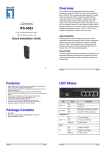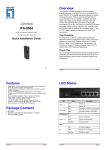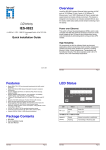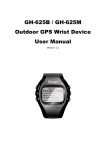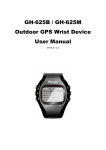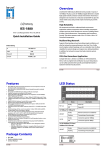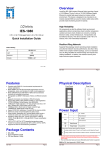Download LevelOne IES-1620
Transcript
Overview LevelOne IES-1620 Industry Ethernet Switch provides 16 ports of 10/100Base-TX Ethernet to enable high speed network at missioncritical environment. This device is designed to be mounted on an industry standard DIN-rail, plus the clearly visible status LEDs provide simple monitoring of port link activity. High Reliability All components are built to withstand harsh environment applications without compromise where humidity, temperature variation and even shock vibration are concerns, including Electric & Utility, Critical Infrastructure, Transportation and Surveillance Security. This device operates under -40 to 75 Celsius (-40 to 167 Fahrenheit) temperature. IES-1620 16 FE Unmanaged Switch -40 to 75, DIN-rail Quick Installation Guide Traffic Control Application This device is certified by NEMA (National Manufacturers Association) TS2 Environmental requirements for the Traffic Control Equipment that withstand extreme temperatures, operating voltage and humidity fluctuation, vibration and shock commonly experienced in severe outdoor environments. Plug & Play This unmanaged Industrial Ethernet Switch is designed for the demanding industrial environments at businesses in need of instant connectivity with no setup or configure required, truly plug and play. v1.00 - 1206 IES-1620 Features Page 1 LED Status Meets NEMA TS1 & TS2 environmental requirements for traffic control equipment. Meets EN61000-6-2 & EN61000-6-3 EMC Generic Standard Immunity for industrial environment. Supports IEEE802.3/802.3u/802.3x. Auto-negotiation: 10/100Mbps, Full/Halfduplex, Auto-Negotiation, Auto MDI/MDIX. 100Base-FX: Multi/Single mode SC or ST type. 100Base-BX: WDM Single mode SC type. Supports 4096 MAC addresses. Provides 1.625M bits buffer memory. Alarms for power failure by relay output 1A @ 24VDC. Power Supplies: Redundant 12-48VDC Terminal Block power inputs and 12VDC DC JACK with 100-240VAC external power supply. Field Wiring Terminal: Use Copper Conductors Only, 60/75℃, 12-24 AWG torque value 7 lb-in. Operating voltage and Max. current consumption: 0.7A @ 12VDC, 0.35A @ 24VDC, 0.175A @ 48VDC. Power consumption: 8.4W Max. -40℃ to 75℃ (-40℉ to 167℉) operating temperature range. Tested for functional operation @ -40℃ to 85℃ (-40℉ to 185℉). UL508 Industrial Control Equipment certified Maximum Surrounding Air Temperature @ 75℃ (167℉). For use in Pollution Degree 2 Environment. Supports DIN-Rail or Panel Mounting installation LED Status Description Steady Power On Off Power Off PW 1,2,3 10/100Base-TX or 100Base-FX/BX LNK/ACT Steady Network connection is established (Green) Flashing Transmitting or Receiving data Package Contents IES-1620 Quick Installation Guide IES-1620 Page 2 IES-1620 Page 3 Power Input DIN Rail Mount + 12 – 48VDC – Power Ground + 12 – 48VDC – Power Ground Assembly: Place the switch on the DIN rail from above using the slot. Push the front of the switch toward the mounting surface until it audibly snaps into place Start-up: Connect the supply voltage to start up the switch via the terminal block (or DC JACK) Dismantling: Pull out the lower edge and then remove the switch from the DIN rail. Terminal Block Power1 Power2 Earth Ground Relay Output 1. The relay contact closes if Power1 or Power2 falls 2. The relay contact closes if Power3 is failed but both Power1 and Power2 are On Power3: 12VDC DC Jack Input type IES-1620 Page 4 IES-1620 Page 5 100Base-FX Connection 10/100Base-TX Connector The following lists the pin-out of 10/100Base-TX ports. The Tx (transmit) port of device I is connected to the Rx (receive) port of device II, and the Rx (receive) port of device I to the Tx (transmit) port of device II. Pin Standard Port Uplink Port 1 Output Transmit Data + Input Receive Data + 2 Output Transmit Data - Input Receive Data - 3 Input Receive Data + Output Transmit Data + 4 NC NC 5 NC NC 6 Input Receive Data - Output Transmit Data - 7 NC NC 8 NC NC IES-1620 WDM 100Base-BX Connection Only one optical fiber is required to transmit and receive data Page 6 IES-1620 Page 7



